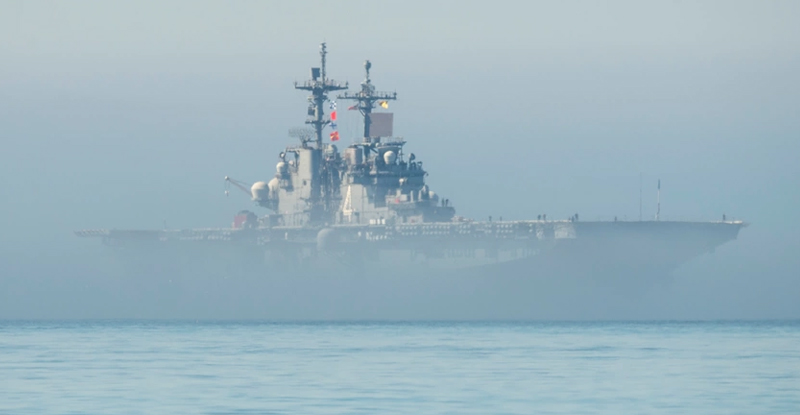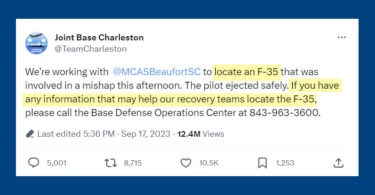By Capt. Brent Ramsey, USN ret
STARRS Board of Advisors
Since 2017, I have written about the decline of the U.S. Navy. We have far fewer ships than we need to defend America. The shipbuilding industry is struggling to produce an ever-decreasing number of ships.
Even if Congress appropriated more funds the shipbuilding industry does not have the capacity to provide more ships, faster. Ships are late in delivery and beset with problems.
We have advanced weaponry that works well as proved by recent use in the middle east, but far too few to last in a sustained conflict. Our enemies overseas see weakness and become bolder.
As good as our missiles are, ships carry limited numbers. Experts warn that we will run out of missiles far sooner than we will run out of targets.
A third of our ships at any given time are not ready for sea due to maintenance issues.
The Navy’s goal is to have seventy-five ships ready to deploy on short notice at any given time. We barely have fifty ready. The Navy set this goal two years ago and recently admitted the goal will not be met. We have little surge capacity, and the so-called ready reserve fleet is deficient having too few ships. The last mobilization readiness stress test ended in failure.
The Navy’s leadership in recent decades has been marked by embarrassing failures.
Examples include building whole ship classes like the Zumwalt and LCS which turned out to be complete failures, collisions at sea, and loss of a sub for 3 years due to a collision with an undersea mount. The Navy lost a capital ship, the USS Bonhomme Richard which burned pier side, a 3-billion-dollar loss to the USMC with no replacement. That failure exacerbates the Navy’s failure to provide the USMC with the Congressionally mandated 38 amphibious ships.
A worsening suicide rate, scandals like Fat Leonard and Red Hill, and an unseemly devotion to politicizing the Navy by celebrating “Pride,” promoting DEI, and diverting resources to fight climate change are all examples of Navy leadership failures.
The Navy has a recruiting crisis being dreadfully shorthanded and now forced to send ships to sea significantly undermanned, a recipe for disaster. The Navy recently reported a shortage of 18,000 sailors for shipboard assignment and for two years running will have missed recruiting goals by thousands. FY 2022 by more that 3000, FY 2023 by more than 10,000 and on track to miss in FY 2024 by another 6700. These shortages are cumulative and impossible to recover from. These shortages persist despite the Navy lowering standards to try to make the goals.
CBO, GAO, CRS, and Heritage Foundation all warn of the severe risk our nation is creating by having a weak Navy. There are increasing doubts that we can win the next war. Our enemies China, Russia, Iran, the DPRK, and radical Islam are all taking advantage of the perceived weakness by being more aggressive.
Russia’s war on Ukraine has no end in sight. Iran is waging a war against the state of Israel, and this is bleeding our inventories dry of arms we will need to fight a looming future conflict with China. China grows ever more aggressive against Taiwan, the Philippines, Japan, and other Pacific nations as it asserts its hegemony against its far weaker neighbors while the U.S. mostly sits idly by tolerating their “wolf warrior” tactics.
Prominent naval experts share my concerns.
Dr. Seth Cropsey began his career as assistant to the Secretary of Defense and was later commissioned as a naval officer. He served as deputy Undersecretary of the Navy in the Reagan administration and acting assistant Secretary of Defense for Special Operations and Low-Intensity Conflict in the George H. W. Bush administration. Following 15 years as a senior fellow at Hudson Institute, Mr. Cropsey founded Yorktown Institute in 2022 and is the Institute’s president. He says in a recent article:
“The U.S. Navy is a ship without a rudder. The longer the service is allowed to decay, the more precarious America’s strategic situation will become. Turning things around won’t be easy. The best solution would be to retain every combat ship in the current fleet and encourage allies to pitch in with their own industrial bases. This expansion will require substantial funding, particularly in the workforce.”
Bryan Clark is a senior fellow and director of the Center for Defense Concepts and Technology at Hudson Institute. He is an expert in naval operations, electronic warfare, autonomous systems, military competitions, and wargaming. Mr. Clark recently made observations regarding the Navy’s management of the USS Constellation Class Frigate:
“The Navy chose a ship design already in use by navies in France and Italy instead of starting from nothing. The idea was that 15% of the vessel would be updated to meet U.S. Navy specifications, while 85% would remain unchanged, reducing costs and speeding construction. Instead, the opposite happened: The Navy redesigned 85% of the ship, resulting in cost increases and construction delays. Construction of the first-in-class Constellation warship, which began in August 2022, is now three years behind schedule, with delivery pushed back to 2029. The final design still isn’t completed.”
Eric Labs is a longtime Navy expert at the Congressional Budget Office. He says the shipbuilding industry is in its worst state in 25 years:
“Navy shipbuilding is currently in “a terrible state” — the worst in a quarter century,” “I feel alarmed,” he said. “I don’t see a fast, easy way to get out of this problem. It’s taken us a long time to get into it.”
Bryan McGrath is a retired naval officer who commanded a Destroyer and helped lead the effort to craft the nation’s maritime strategy 2007. Since retiring in 2008, McGrath has been a key Navy consultant on strategy, concepts of operation, and capability development to both the Navy and the defense industry. He said in early 2024:
“The U.S. Navy is too small for what is asked of it, and what is asked of it is insufficient to meet the nation’s needs. We have too few ships, submarines, aircraft, aircraft carriers, people, sensors, weapons, and networks. China’s People’s Liberation Army Navy (PLAN) is growing faster than any navy has since the U.S. buildup to the Second World War, while the U.S. remains committed to efficient peacetime production levels that ignore the reality of this competition. Relative to the threats it faces, American naval power is weaker than at any time since the start of World War II. While the U.S. Navy remains the world’s most powerful seaborne combat force, not even the Soviet navy posed as dangerous a threat as China’s PLAN does today. The nature of that threat presents the prospect of a PLAN so powerful it could dominate the Western Pacific, destroying the legitimacy and effectiveness of America’s network of friends and allies by raising questions about America’s will and capability to support that network. The ability to dominate a region of the world responsible for 65% of global GDP represents a profound threat to U.S. national security and prosperity, and that of like-minded nations globally. A broad-based naval building program is required to meet China’s challenge, and all elements of the modern, balanced fleet should expand.”
Dr. James Holmes is J. C. Wylie Chair of Maritime Strategy at the Naval War College and a Distinguished Fellow at the Brute Krulak Center for Innovation & Future Warfare, Marine Corps University. Professor Holmes recently wrote in National Interest:
“The U.S. Navy has been breaching the principle of continuity for decades, and to its own peril. At present, for example, surface combatants—guided-missile destroyers and cruisers—have to withdraw from a battle zone when they exhaust their missile inventories. They have to steam back to a specially equipped port to rearm. The logistics fleet cannot rearm them at sea for fear of damaging munitions or vertical launchers as the recipient and delivery ships sway with the waves. Depending on where the theater of conflict lies, the simple feat of rearming could mean voyaging thousands of miles—perhaps even all the way to a U.S. seaport. Such a journey would deduct whatever fraction that ship contributes to the fleet’s overall fighting strength—96 vertical launch siloes’ worth of missiles in the case of a destroyer, the surface navy’s workhorse—for weeks at a time.”
CDR Salamander is a retired Navy Commander and a former Commanding Officer of a Destroyer. He’s been writing an insightful column for many years on all things related to the Navy. I highly recommend his Substack which can be found at this link. Recently he wrote about the Navy’s amphibious forces. He asks, “What has the 29-year old BOXER been up to? Well, earlier this month:
“The amphibious assault ship USS Boxer is underway for a long-delayed deployment after a maintenance and overhaul period of almost four years. The ship has been conducting workups for the last several months with the 15th Marine Expeditionary Unit. The Boxer last deployed in 2019. The Navy struggled to get the ship back to sea after a $200 million planned overhaul and maintenance availability in 2020. Wait … less than a couple of weeks later – what do we see? The trouble-plagued USS Boxer has returned to San Diego after experiencing a new equipment problem during its first deployment in five years.”
Brent Sadler is Senior Research Fellow, Allison Center for National Security at the Heritage Foundation. In July 2024 He wrote:
“Our nation’s maritime strength has been ebbing for years, but few policymakers have taken notice let alone real action—until now. More and more members of Congress are speaking up, with many determined to fix what has turned into a national strategic vulnerability. For example, Sen. Roger Wicker (R-Miss.) recently announced plans to increase defense spending by $55 billion to get industry “on a footing to deliver a 355-ship” Navy. It’s a long-overdue change. Barely 0.4 percent of our trade is conducted on U.S. ships, leaving our security and prosperity in the hands of Chinese state enterprises that are increasingly dominating every aspect of maritime activity. To reduce our overreliance on unfriendly nations, Congress must revive a critical industry that will require action in workforce, shipyards, shipbuilding, and shipping. Regaining American competitiveness is key. A successful renaissance in American shipping will allow us to build momentum and set conditions for a sustained revival in America’s maritime industry.”
As the old saw goes, “A word to the wise is sufficient.”
We must rebuild our Navy. We are a maritime nation. Our lives and economy depend on the sea.
There is no time to waste. Contact your Congressional representatives now!
CAPT Brent Ramsey, (USN, Ret.) has written extensively on Defense matters. He is an officer with Calvert Task Group, Board of Advisors member for the Center for Military Readiness and STARRS, and member of the Military Advisory Group for Congressman Chuck Edwards (NC-11).








Leave a Comment